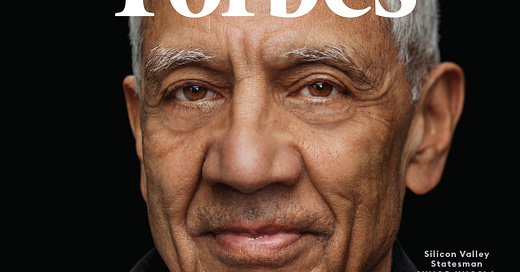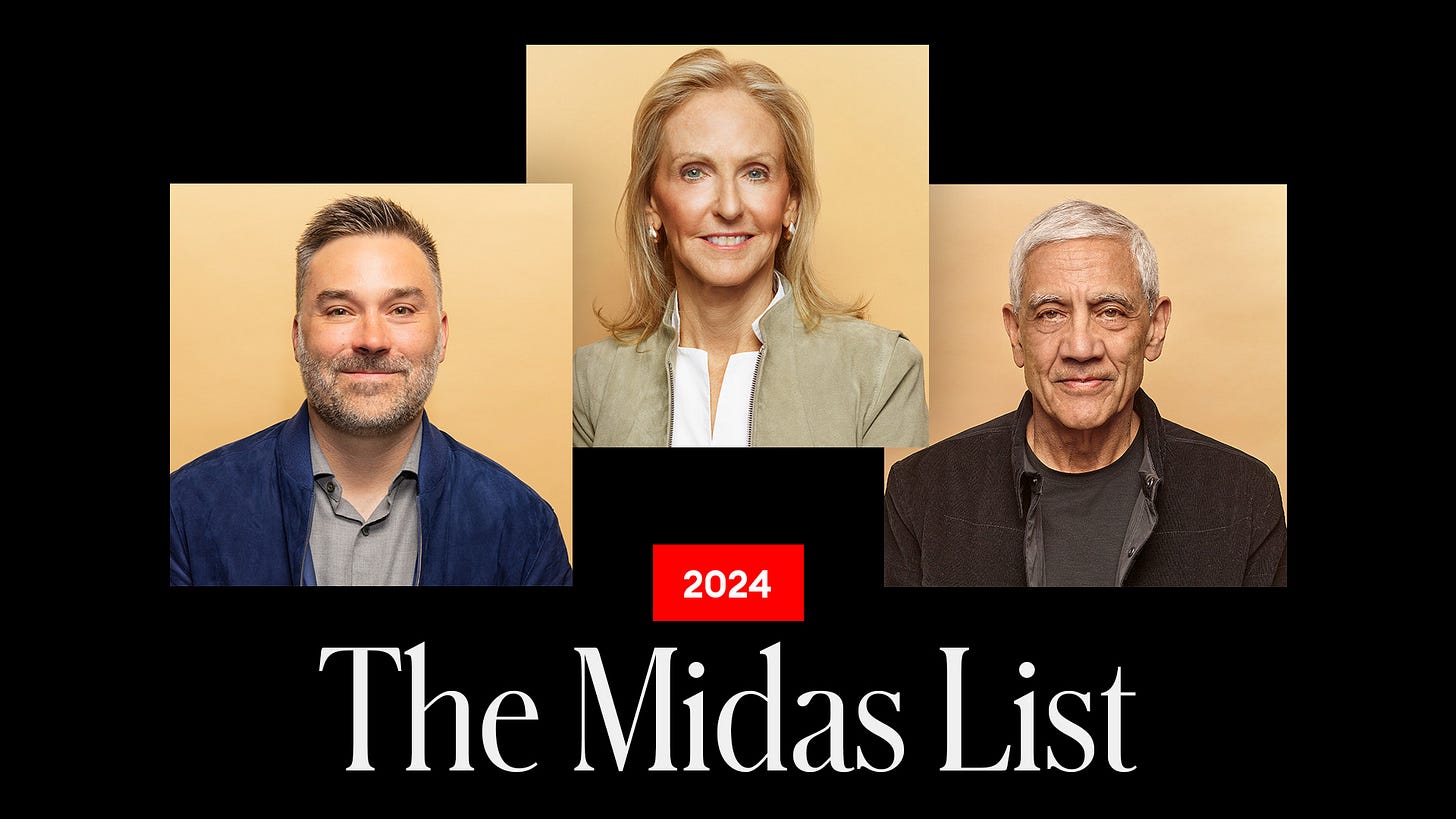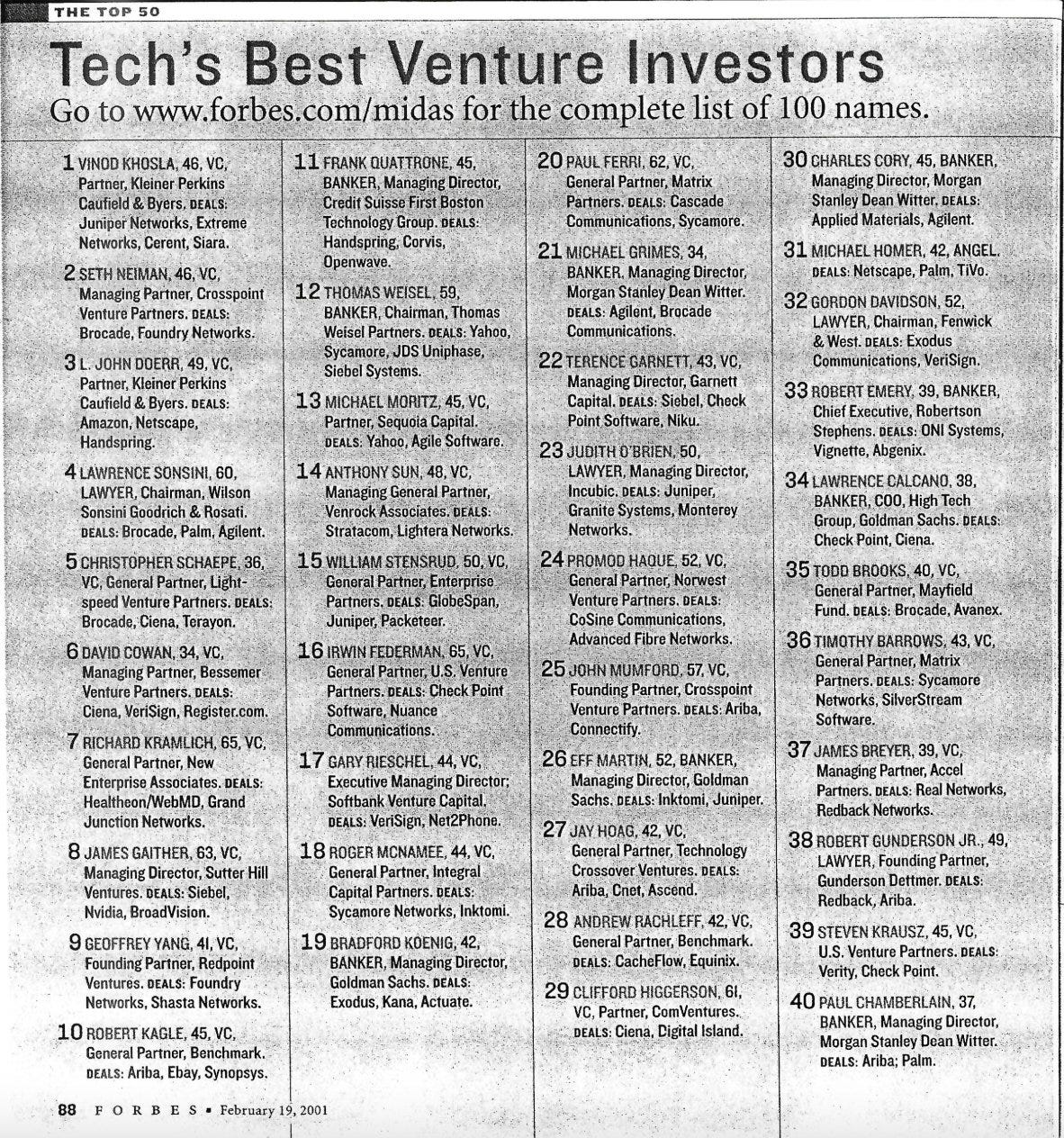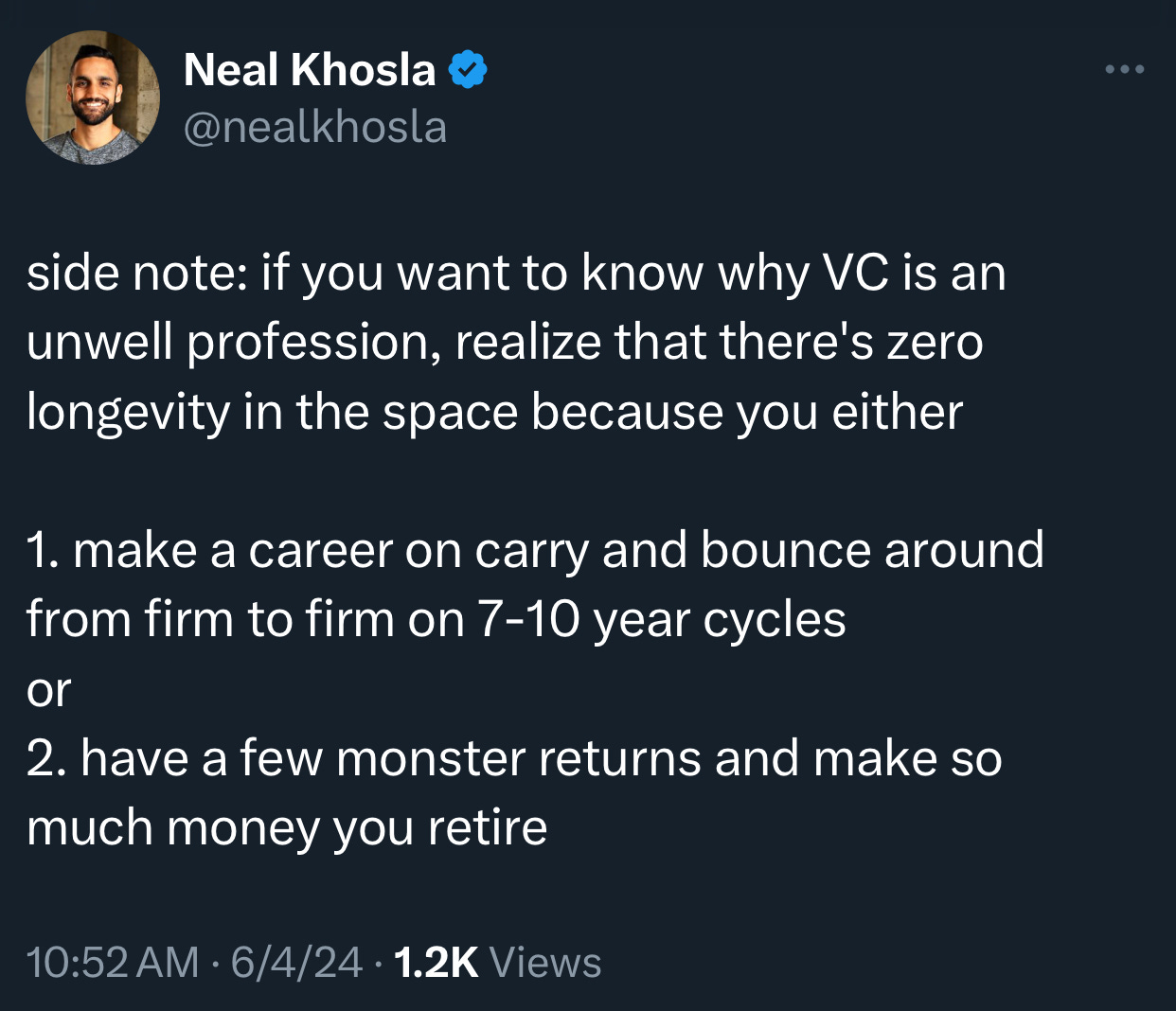Forbes VC Rankings Are Why VCs Suck at Investing
I propose two concrete changes to the VC investing to prevent the massive misallocation of capital by VCs.
Welcome to AI Health Uncut, a brutally honest newsletter on AI, innovation, and the state of the healthcare market. If you’d like to sign up to receive issues over email, you can do so here.
Forbes just dropped its 2024 list of the top 100 venture capitalists. Follow this story closely because this list reveals a lot about what’s wrong with venture capital investing today. This ranking is also an eerie confirmation of my ‘pump & dump’ theory on private valuations by VC firms, which I detailed in my last article. The unfortunate demise of Cue Health serves as a prime example of the lies and gross misallocation of capital by “VC bros”, particularly in digital health.
It’s all coming together, and it’s absolutely terrifying.
Here is a snapshot of the 2024 Forbes ranking of VC funds:
First of all, let’s take a moment to appreciate who’s at number 10: our old pal Hemant Taneja, CEO of General Catalyst. Loyal readers of my newsletter may recall that this guy recently bought a hospital he couldn’t afford by borrowing a cool billion and dumping the debt onto the hospital’s balance sheet. To pull off this magic trick, he created HATCo, a shell company hilariously claimed to stand for “Health Assurance Transformation Corporation”. But let’s be real. The name is likely a nod to Hemant Taneja’s own initials. It’s straight out of the playbook of those narcissistic S&L CEOs from the 1980s who loved plastering their initials on their companies’ market trading tickers, much like a certain former president.
In my public comment to the Federal Trade Commission (FTC), Department of Justice (DOJ), and Department of Health and Human Services (HHS) about Consolidation in Health Care, I argue that what Mr. Taneja and General Catalyst are doing is a Ponzi scheme. By creating a shell company to dodge potential bankruptcy inquiries and shoving all this debt onto someone else’s books, they’re playing a dangerous game.
Three key things to notice from the Forbes ranking:
1. Only one name remains from a similar list from 23 years ago: Vinod Khosla.
Granted, the methodology of these rankings is far from perfect, as I explain in bullet point 3 below. It’s no secret that many of these names are “talking heads” without a consistent record of financial returns. But it is still interesting that only one single person is highlighted in both rankings: Vinod Khosla, the co-founder of Sun Microsystems and a venture capitalist.
Unfortunately, what Forbes failed to mention is that Vinod Khosla is also known as “The Forecaster Without the Horizon”.
Mr. Khosla tends to make outrageous predictions, give a series of interviews and conference appearances regarding those predictions. Then, when those predictions don’t come true, he just extends the forecast horizon without admitting any mistakes.
I’m not saying predictions in finance and technology are easy. I’m just saying that if you say something will happen and it doesn’t, you ought to own that. It’s OK to make mistakes. (My whole life is a series of mistakes.)
For example, Mr. Khosla made a prediction in 2012 that AI could replace 80% of what doctors do. He suggested that the healthcare industry could be significantly disrupted by the application of algorithms and artificial intelligence. (Sources: Impact Lab, The Healthcare Blog, Venture Beat.)
In a 2016 paper titled “20 Percent Doctor Included”, Khosla doubled down on this idea, arguing that a significant portion of healthcare could be automated. He continued to advocate for the transformative potential of AI in healthcare, predicting in 2023 that within 5 to 6 years, the FDA would approve a primary care app qualified to practice medicine like a primary care physician. (Sources: Khosla Ventures, STAT News.)
None of Khosla’s predictions have come true so far. In fact, the United States is experiencing the largest shortage of human physicians in its history.
But of course, Forbes would never mention this fact.
This reminds me of another “investment guru”, Nassim Taleb, an expert on “black swan” events, such as market crashes. Predicting a crash is an unforgiving endeavor. Mr. Taleb ran two hedge funds into the ground, essentially predicting every year that the following year would bring a crash. With that strategy, you’d be right only once every 13 years. After losing money for his investors, he decided that writing books and pretending you’re an expert on crashes is a much more profitable path.
2. The largest VC firms in number of assets are represented very well, especially near the top of the list
Out of the 12 top-ranked VC funds, according to Forbes, 8 have at least $12 billion in assets under management (AUM). Ranked at number 2, Ribbit Capital alone manages more than $227 billion!
Why does size matter? Shockingly, outside this “fishbowl” of the VC world, smaller investment firms have more flexibility in allocating their investments and, therefore, delivering higher returns. However, remember, in the perverse world of venture capital driven by corporate media, returns don’t matter. It’s about how many startups you can push into IPOs and how many “unicorns” you’ve got. (See bullet point 3 below.) So in this twisted reality, size absolutely matters. If you can afford to have 1000 investments versus only 10, solely by the law of large numbers, you can push more startups to an IPO. And also, by the law of large numbers, 1 of these 1000 investments may turn out to be that “holy grail” of a unicorn. Therefore, you’ll have a much higher chance of being on top of the Forbes ranking, wielding an implicit advantage over your competitors.
Returns? What returns? You’ve got your IPO, so fuhgeddaboudit!
3. According to Forbes’ methodology for constructing these VC rankings, “investors are ranked by portfolio companies that have gone public or been acquired for at least $200 million in the past five years, or that have at least doubled their private valuation to $400 million”.
Regarding this last point, those who have read my latest research article on how VC firms use completely unregulated private financing rounds to jack up the price of an (often shitty) startup and then push that startup into an IPO by any means necessary understand the perverse motivations of the “VC bros”. They are not being measured by the eventual success of the startup or customer/patient/doctor satisfaction. Heck, they are not even being measured by ROI or any financial metrics, for that matter.
All that matters is the number of IPOs (i.e. the number of “exits”) and how well you can play the game of ‘pump & dump’.
In digital health, this kind of dysfunctional VC investing has ended up in a complete disaster. As fast as private valuation was (suspiciously) going up before the IPO, the public valuation was plummeting even faster. (The infamous “inverse V” chart, as I illustrate in my article.) Notice from the table above that for most of these startups, these near 100% losses have happened only over the past 4-5 years - as the broad market has continued to beat record highs! Just look at this sea of red. Something ain’t right in digital health, and unfortunately VC firms have had their share of contribution.
I’m especially astonished that respected corporate media promotes these perverse motivations of VC firms, encourages the hype of lottery outcomes of “unicorns”, and completely ignores the typical investor experience with these VC firms, which is unfortunately not 100x returns and not even 2x returns. Where is the journalistic integrity? I understand these same companies may be Forbes’ sponsors and advertisers. But what about ethics, honesty, and doing your job right? The “revolving door” problem among corporate journalists in America is real.
As for general partners of these VC firms, don’t they have honesty and integrity? Most of them went to Ivy League business schools where they were taught by the best finance and statistics professors about survivorship bias. Yet, they seem to have completely forgotten about that and are in the perennial hunt for the “next Google”. Out of 1000 investments, these VC partners may have 999 failures. But if they have that one “unicorn”, that one Tesla or OpenAI, they are considered geniuses and are praised by leading media publications such as Forbes.
The system of capital allocation, particularly in healthcare technology, is dysfunctional.
Here are my two simple suggestions for fixing venture capital investing:
1️⃣ The motivation for venture capital must change. For starters, introduce an ESG (Environmental, Social, and Governance) investing methodology. This approach has become popular in the rest of the investment world over the past 20 years. It includes not just investment returns (which VC firms haven’t seen much of lately anyway), but also social measures. For instance, ask, “How has the well-being of patients improved from the moment the VC firm invested in the digital health company until its exit?”
2️⃣ VC firms should not be allowed to “flip the house”, especially right before the IPO. Create a “lockup period”, for example, from T-1 year to T+2 years. If the VC bros truly believe in the startup’s future and its founders’ vision as they claim, then this lockup period shouldn’t be a problem for them.
Unconstrained profit optimization hasn’t worked for venture capital. They’ve converted it into “General Partner profit optimization”, resulting in immense capital misallocation for the rest of the industry. These two constraints I’m proposing will help allocate capital to where it’s needed the most—true innovators who aren’t necessarily be the loudest “visionaries” the VC bros are so obsessed with.
👉👉👉👉👉 Hi! My name is Sergei Polevikov. In my newsletter ‘AI Health Uncut’, I combine my knowledge of AI models with my unique skills in analyzing the financial health of digital health companies. Why “Uncut”? Because I never sugarcoat or filter the hard truth. I don’t play games, I don’t work for anyone, and therefore, with your support, I produce the most original, the most unbiased, the most unapologetic research in AI, innovation, and healthcare. Thank you for your support of my work. You’re part of a vibrant community of healthcare AI enthusiasts! Your engagement matters. 🙏🙏🙏🙏🙏















I broadly agree with this—especially the "returns don't matter" thing. It's actually become quite frustrating to me from the VC chair, since most LPs seem to have no idea what returns actually are / are expected / will be. I kind of understand given how long the timeframe is for VC funds, but this becomes a game of "flashiest salesperson" or "shinest object" (which is what this Forbes ranking is).
Regarding the changes though, I have some unfortunate news that at least at base level, these are already implemented without fixing the issue.
1) ESG methodologies: most all VCs have adopted them (along with DEI statements). They generally mean nothing, aside from not investing in stuff like human trafficking. Creative has an ESG policy, but because of my personal bad experiences with how non-profits run, it calls out the absurdity of most policies in letter and talks about how we try to follow the principles in spirit.
2) Lock-up periods—some VCs may be able to keep these at a minimum, but 180 days post-IPO is fairly standard as an imposition from investment banks. Some even go to 1-year. Unfortunately, to go longer would also start to make a lot of business unviable (because LPs demand their money back). They'd probably all just do other things to get around it, in terms of M&As-only, or something weird like SPACs again. Or they would try to shove this off in-kind (as shares) to LPs. You may be right that the price collapses post-IPO, but pump-and-dump should probably be an analysis not from day-1 of IPO, but ~180 days after.